Individual Investigation Report: Tourism and Hospitality Management
VerifiedAdded on 2023/02/01
|7
|1557
|98
Report
AI Summary
This report analyzes the structure and functions of hospitality and tourism management, focusing on four key contexts: operational, human resource, financial, and product and markets. The operational context highlights the high level of competition and the need for sustainable development, competitive advantage, and climate change considerations. The human resource context emphasizes the importance of skilled labor, service quality, employee motivation, and addressing challenges like training and labor mobility. The financial context discusses financial management features, including cash flow, foreign exchange, and capital intensity, along with the use of financial analysis tools. Finally, the product and markets context stresses the significance of strategic marketing, understanding market dynamics, and employing strategies like digital marketing and STP marketing to improve business processes. The report uses at least eight scholarly publications to support its findings, adhering to a professional structure and Harvard referencing style.
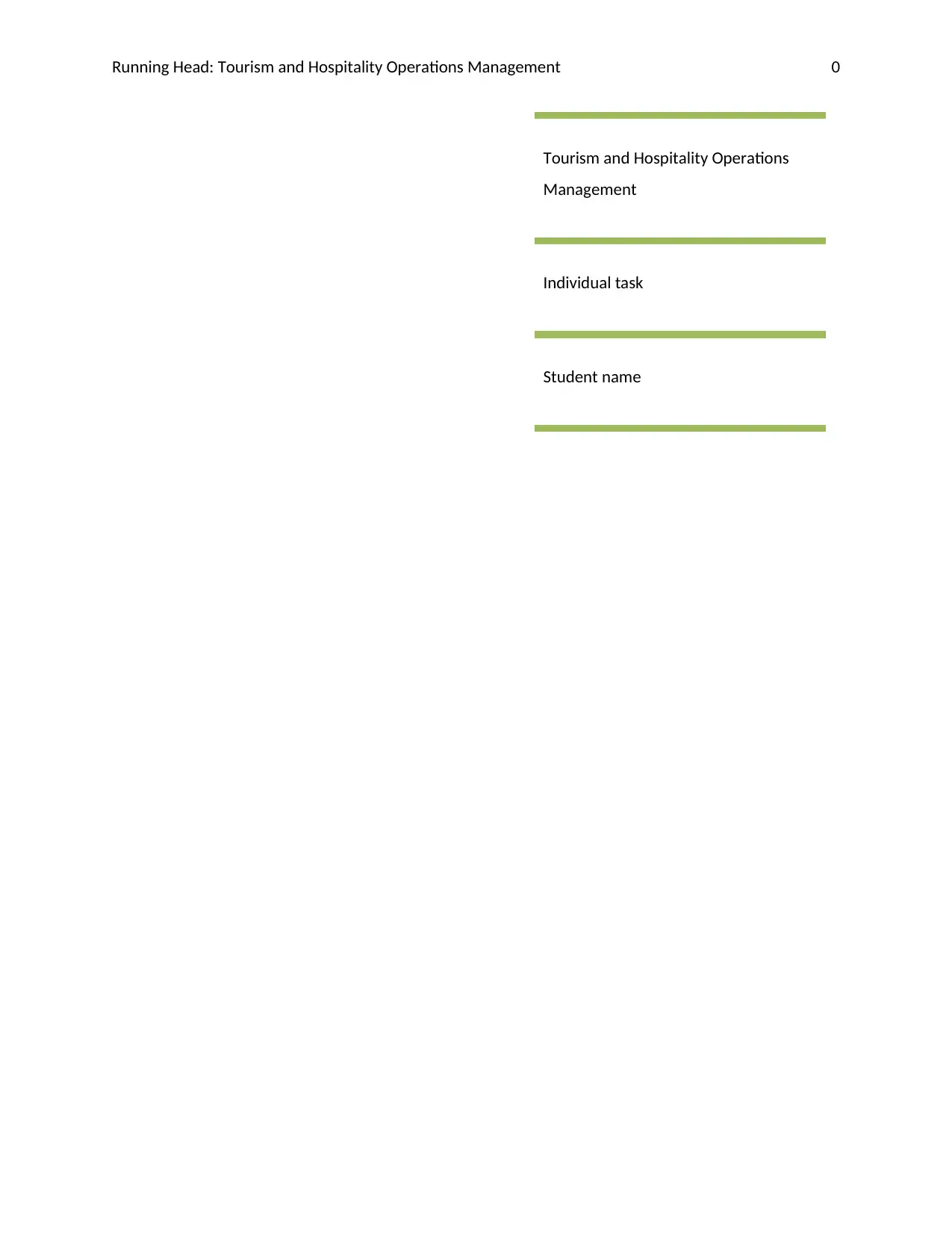
Running Head: Tourism and Hospitality Operations Management 0
Tourism and Hospitality Operations
Management
Individual task
Student name
Tourism and Hospitality Operations
Management
Individual task
Student name
Paraphrase This Document
Need a fresh take? Get an instant paraphrase of this document with our AI Paraphraser
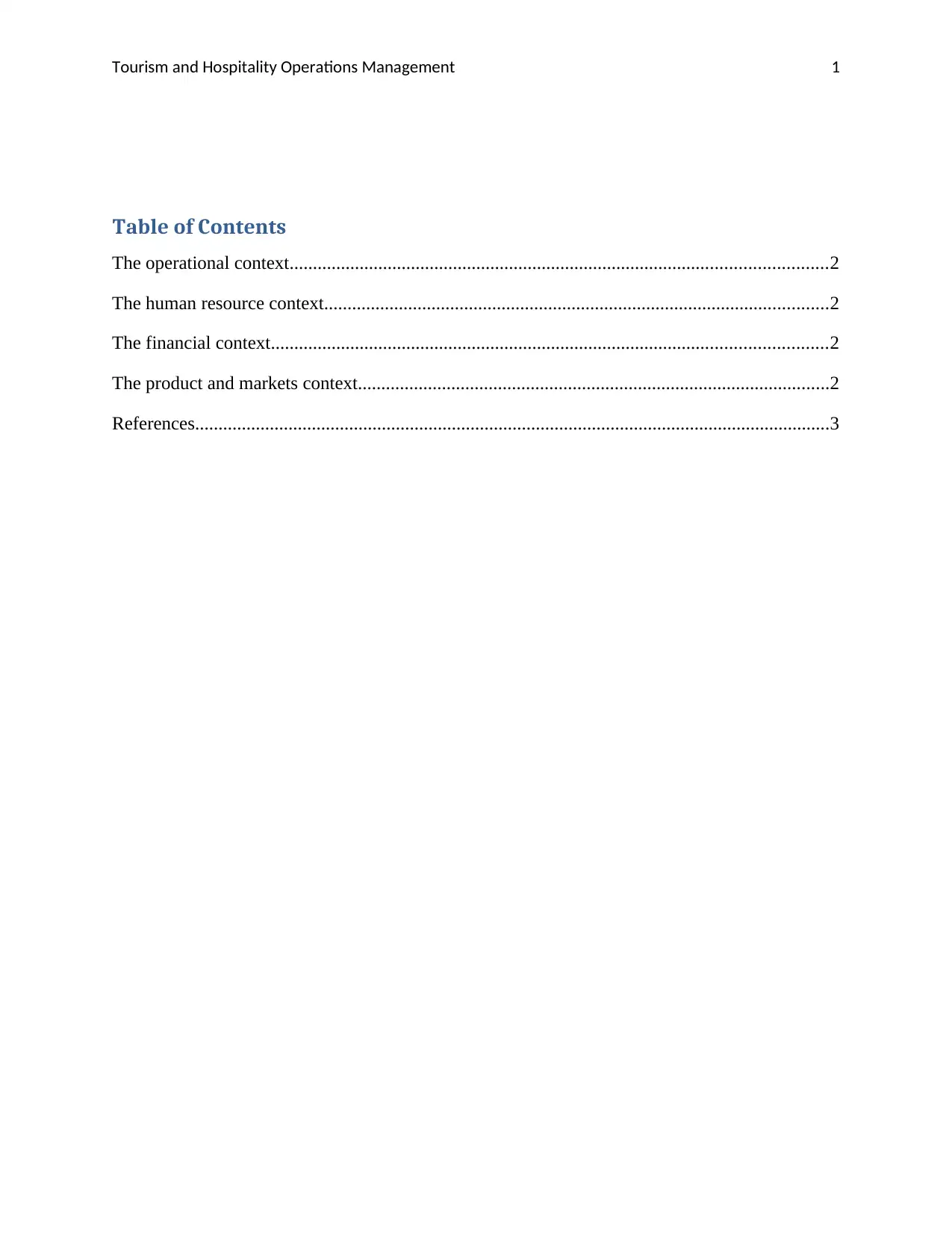
Tourism and Hospitality Operations Management 1
Table of Contents
The operational context...................................................................................................................2
The human resource context............................................................................................................2
The financial context.......................................................................................................................2
The product and markets context.....................................................................................................2
References........................................................................................................................................3
Table of Contents
The operational context...................................................................................................................2
The human resource context............................................................................................................2
The financial context.......................................................................................................................2
The product and markets context.....................................................................................................2
References........................................................................................................................................3
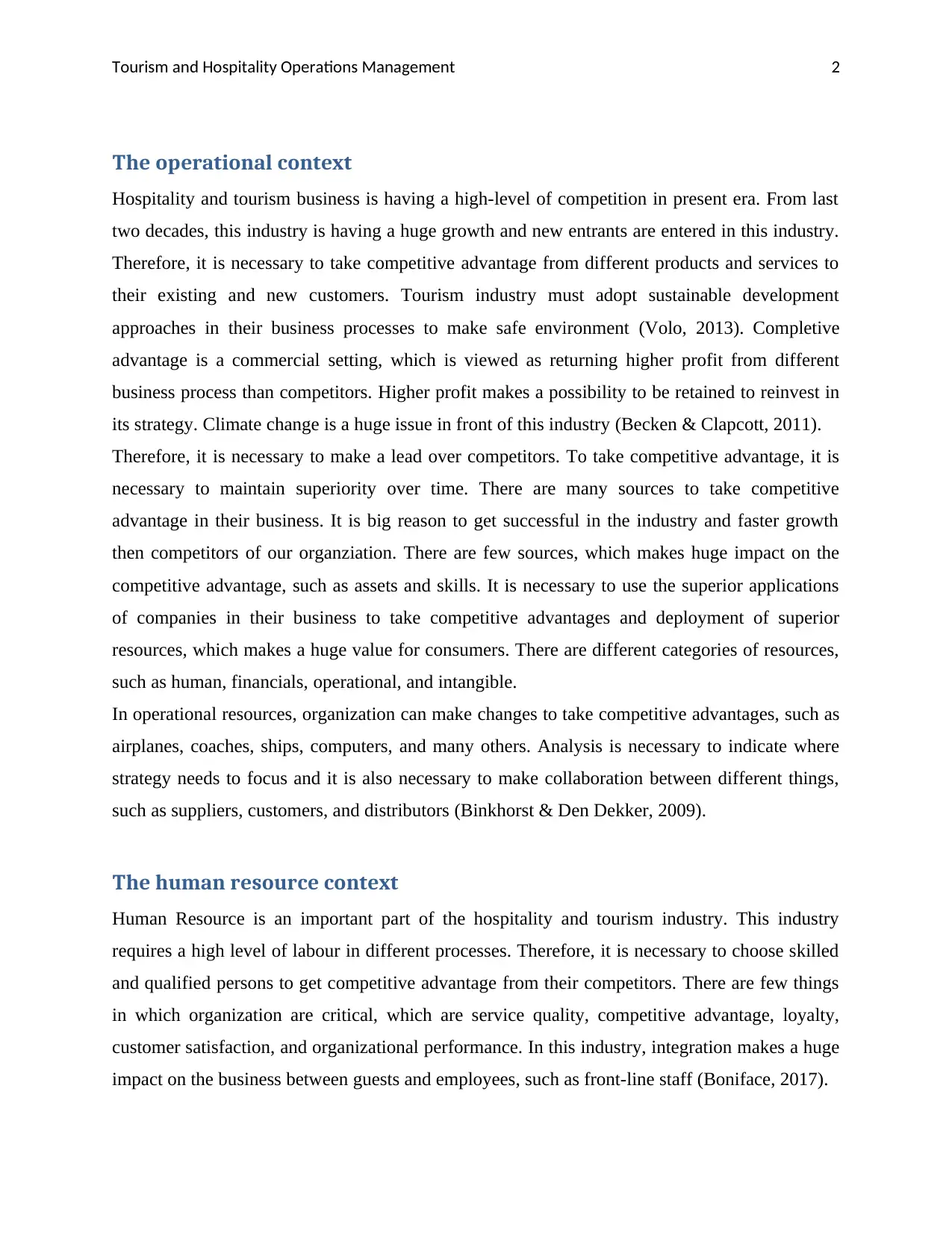
Tourism and Hospitality Operations Management 2
The operational context
Hospitality and tourism business is having a high-level of competition in present era. From last
two decades, this industry is having a huge growth and new entrants are entered in this industry.
Therefore, it is necessary to take competitive advantage from different products and services to
their existing and new customers. Tourism industry must adopt sustainable development
approaches in their business processes to make safe environment (Volo, 2013). Completive
advantage is a commercial setting, which is viewed as returning higher profit from different
business process than competitors. Higher profit makes a possibility to be retained to reinvest in
its strategy. Climate change is a huge issue in front of this industry (Becken & Clapcott, 2011).
Therefore, it is necessary to make a lead over competitors. To take competitive advantage, it is
necessary to maintain superiority over time. There are many sources to take competitive
advantage in their business. It is big reason to get successful in the industry and faster growth
then competitors of our organziation. There are few sources, which makes huge impact on the
competitive advantage, such as assets and skills. It is necessary to use the superior applications
of companies in their business to take competitive advantages and deployment of superior
resources, which makes a huge value for consumers. There are different categories of resources,
such as human, financials, operational, and intangible.
In operational resources, organization can make changes to take competitive advantages, such as
airplanes, coaches, ships, computers, and many others. Analysis is necessary to indicate where
strategy needs to focus and it is also necessary to make collaboration between different things,
such as suppliers, customers, and distributors (Binkhorst & Den Dekker, 2009).
The human resource context
Human Resource is an important part of the hospitality and tourism industry. This industry
requires a high level of labour in different processes. Therefore, it is necessary to choose skilled
and qualified persons to get competitive advantage from their competitors. There are few things
in which organization are critical, which are service quality, competitive advantage, loyalty,
customer satisfaction, and organizational performance. In this industry, integration makes a huge
impact on the business between guests and employees, such as front-line staff (Boniface, 2017).
The operational context
Hospitality and tourism business is having a high-level of competition in present era. From last
two decades, this industry is having a huge growth and new entrants are entered in this industry.
Therefore, it is necessary to take competitive advantage from different products and services to
their existing and new customers. Tourism industry must adopt sustainable development
approaches in their business processes to make safe environment (Volo, 2013). Completive
advantage is a commercial setting, which is viewed as returning higher profit from different
business process than competitors. Higher profit makes a possibility to be retained to reinvest in
its strategy. Climate change is a huge issue in front of this industry (Becken & Clapcott, 2011).
Therefore, it is necessary to make a lead over competitors. To take competitive advantage, it is
necessary to maintain superiority over time. There are many sources to take competitive
advantage in their business. It is big reason to get successful in the industry and faster growth
then competitors of our organziation. There are few sources, which makes huge impact on the
competitive advantage, such as assets and skills. It is necessary to use the superior applications
of companies in their business to take competitive advantages and deployment of superior
resources, which makes a huge value for consumers. There are different categories of resources,
such as human, financials, operational, and intangible.
In operational resources, organization can make changes to take competitive advantages, such as
airplanes, coaches, ships, computers, and many others. Analysis is necessary to indicate where
strategy needs to focus and it is also necessary to make collaboration between different things,
such as suppliers, customers, and distributors (Binkhorst & Den Dekker, 2009).
The human resource context
Human Resource is an important part of the hospitality and tourism industry. This industry
requires a high level of labour in different processes. Therefore, it is necessary to choose skilled
and qualified persons to get competitive advantage from their competitors. There are few things
in which organization are critical, which are service quality, competitive advantage, loyalty,
customer satisfaction, and organizational performance. In this industry, integration makes a huge
impact on the business between guests and employees, such as front-line staff (Boniface, 2017).
⊘ This is a preview!⊘
Do you want full access?
Subscribe today to unlock all pages.

Trusted by 1+ million students worldwide
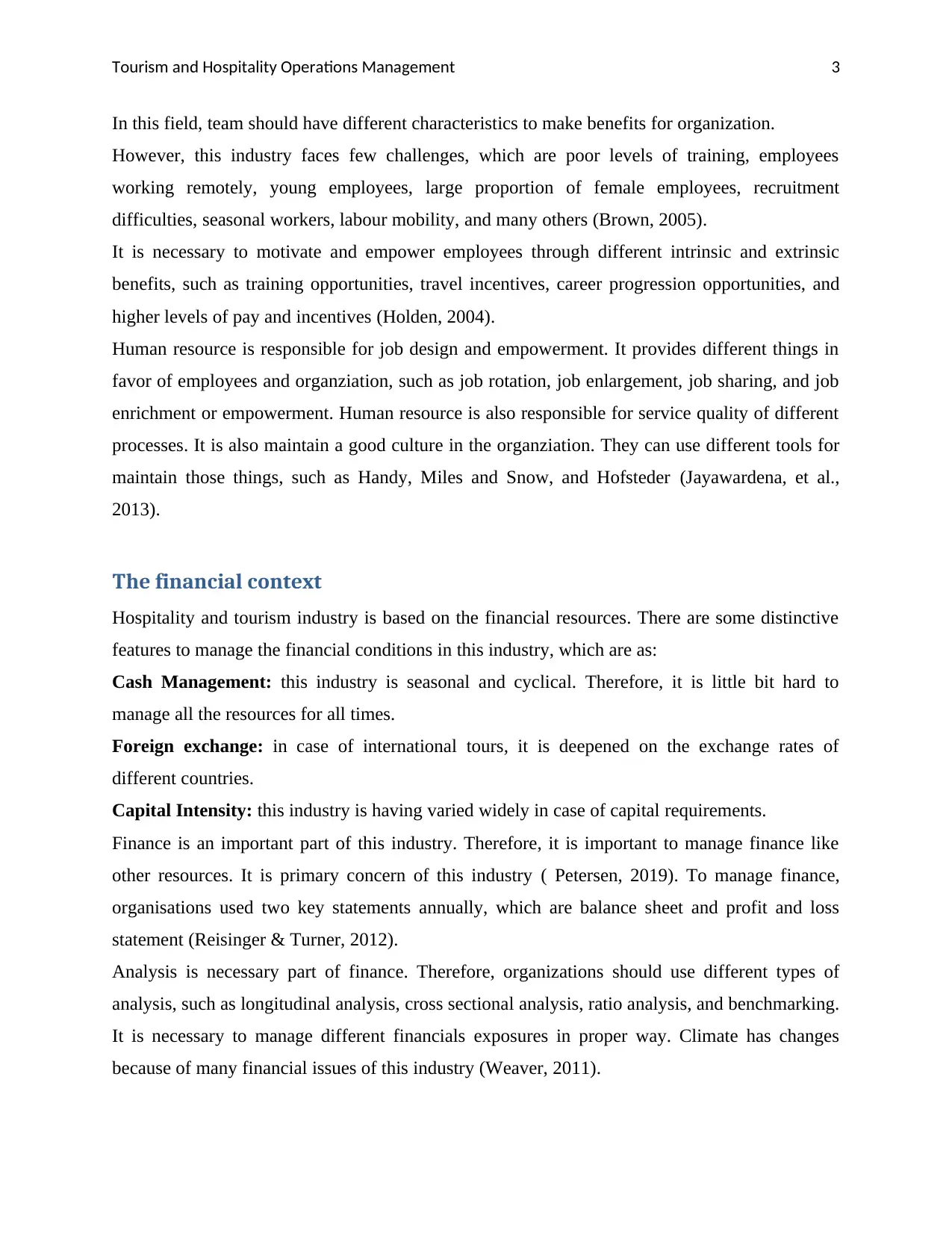
Tourism and Hospitality Operations Management 3
In this field, team should have different characteristics to make benefits for organization.
However, this industry faces few challenges, which are poor levels of training, employees
working remotely, young employees, large proportion of female employees, recruitment
difficulties, seasonal workers, labour mobility, and many others (Brown, 2005).
It is necessary to motivate and empower employees through different intrinsic and extrinsic
benefits, such as training opportunities, travel incentives, career progression opportunities, and
higher levels of pay and incentives (Holden, 2004).
Human resource is responsible for job design and empowerment. It provides different things in
favor of employees and organziation, such as job rotation, job enlargement, job sharing, and job
enrichment or empowerment. Human resource is also responsible for service quality of different
processes. It is also maintain a good culture in the organziation. They can use different tools for
maintain those things, such as Handy, Miles and Snow, and Hofsteder (Jayawardena, et al.,
2013).
The financial context
Hospitality and tourism industry is based on the financial resources. There are some distinctive
features to manage the financial conditions in this industry, which are as:
Cash Management: this industry is seasonal and cyclical. Therefore, it is little bit hard to
manage all the resources for all times.
Foreign exchange: in case of international tours, it is deepened on the exchange rates of
different countries.
Capital Intensity: this industry is having varied widely in case of capital requirements.
Finance is an important part of this industry. Therefore, it is important to manage finance like
other resources. It is primary concern of this industry ( Petersen, 2019). To manage finance,
organisations used two key statements annually, which are balance sheet and profit and loss
statement (Reisinger & Turner, 2012).
Analysis is necessary part of finance. Therefore, organizations should use different types of
analysis, such as longitudinal analysis, cross sectional analysis, ratio analysis, and benchmarking.
It is necessary to manage different financials exposures in proper way. Climate has changes
because of many financial issues of this industry (Weaver, 2011).
In this field, team should have different characteristics to make benefits for organization.
However, this industry faces few challenges, which are poor levels of training, employees
working remotely, young employees, large proportion of female employees, recruitment
difficulties, seasonal workers, labour mobility, and many others (Brown, 2005).
It is necessary to motivate and empower employees through different intrinsic and extrinsic
benefits, such as training opportunities, travel incentives, career progression opportunities, and
higher levels of pay and incentives (Holden, 2004).
Human resource is responsible for job design and empowerment. It provides different things in
favor of employees and organziation, such as job rotation, job enlargement, job sharing, and job
enrichment or empowerment. Human resource is also responsible for service quality of different
processes. It is also maintain a good culture in the organziation. They can use different tools for
maintain those things, such as Handy, Miles and Snow, and Hofsteder (Jayawardena, et al.,
2013).
The financial context
Hospitality and tourism industry is based on the financial resources. There are some distinctive
features to manage the financial conditions in this industry, which are as:
Cash Management: this industry is seasonal and cyclical. Therefore, it is little bit hard to
manage all the resources for all times.
Foreign exchange: in case of international tours, it is deepened on the exchange rates of
different countries.
Capital Intensity: this industry is having varied widely in case of capital requirements.
Finance is an important part of this industry. Therefore, it is important to manage finance like
other resources. It is primary concern of this industry ( Petersen, 2019). To manage finance,
organisations used two key statements annually, which are balance sheet and profit and loss
statement (Reisinger & Turner, 2012).
Analysis is necessary part of finance. Therefore, organizations should use different types of
analysis, such as longitudinal analysis, cross sectional analysis, ratio analysis, and benchmarking.
It is necessary to manage different financials exposures in proper way. Climate has changes
because of many financial issues of this industry (Weaver, 2011).
Paraphrase This Document
Need a fresh take? Get an instant paraphrase of this document with our AI Paraphraser
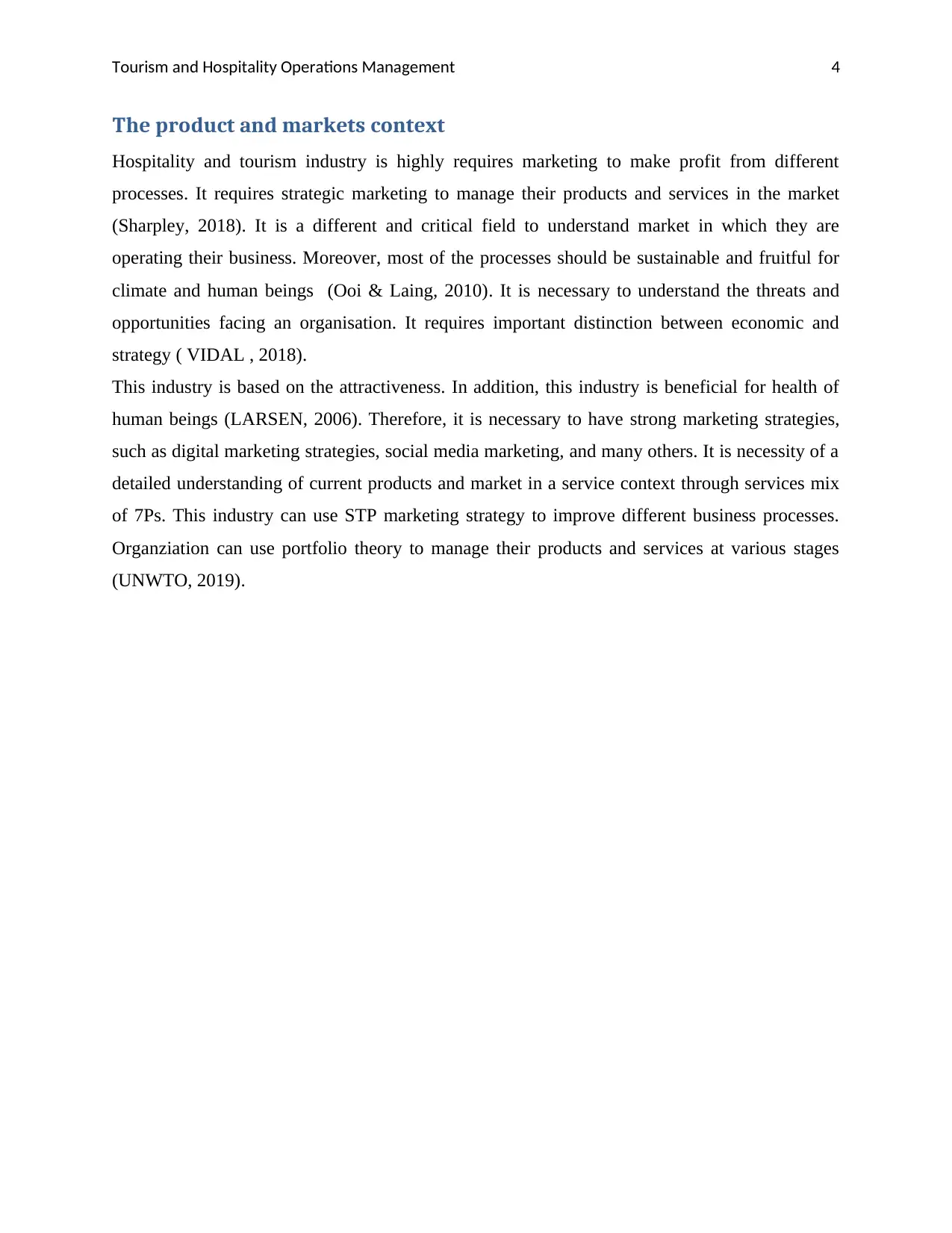
Tourism and Hospitality Operations Management 4
The product and markets context
Hospitality and tourism industry is highly requires marketing to make profit from different
processes. It requires strategic marketing to manage their products and services in the market
(Sharpley, 2018). It is a different and critical field to understand market in which they are
operating their business. Moreover, most of the processes should be sustainable and fruitful for
climate and human beings (Ooi & Laing, 2010). It is necessary to understand the threats and
opportunities facing an organisation. It requires important distinction between economic and
strategy ( VIDAL , 2018).
This industry is based on the attractiveness. In addition, this industry is beneficial for health of
human beings (LARSEN, 2006). Therefore, it is necessary to have strong marketing strategies,
such as digital marketing strategies, social media marketing, and many others. It is necessity of a
detailed understanding of current products and market in a service context through services mix
of 7Ps. This industry can use STP marketing strategy to improve different business processes.
Organziation can use portfolio theory to manage their products and services at various stages
(UNWTO, 2019).
The product and markets context
Hospitality and tourism industry is highly requires marketing to make profit from different
processes. It requires strategic marketing to manage their products and services in the market
(Sharpley, 2018). It is a different and critical field to understand market in which they are
operating their business. Moreover, most of the processes should be sustainable and fruitful for
climate and human beings (Ooi & Laing, 2010). It is necessary to understand the threats and
opportunities facing an organisation. It requires important distinction between economic and
strategy ( VIDAL , 2018).
This industry is based on the attractiveness. In addition, this industry is beneficial for health of
human beings (LARSEN, 2006). Therefore, it is necessary to have strong marketing strategies,
such as digital marketing strategies, social media marketing, and many others. It is necessity of a
detailed understanding of current products and market in a service context through services mix
of 7Ps. This industry can use STP marketing strategy to improve different business processes.
Organziation can use portfolio theory to manage their products and services at various stages
(UNWTO, 2019).
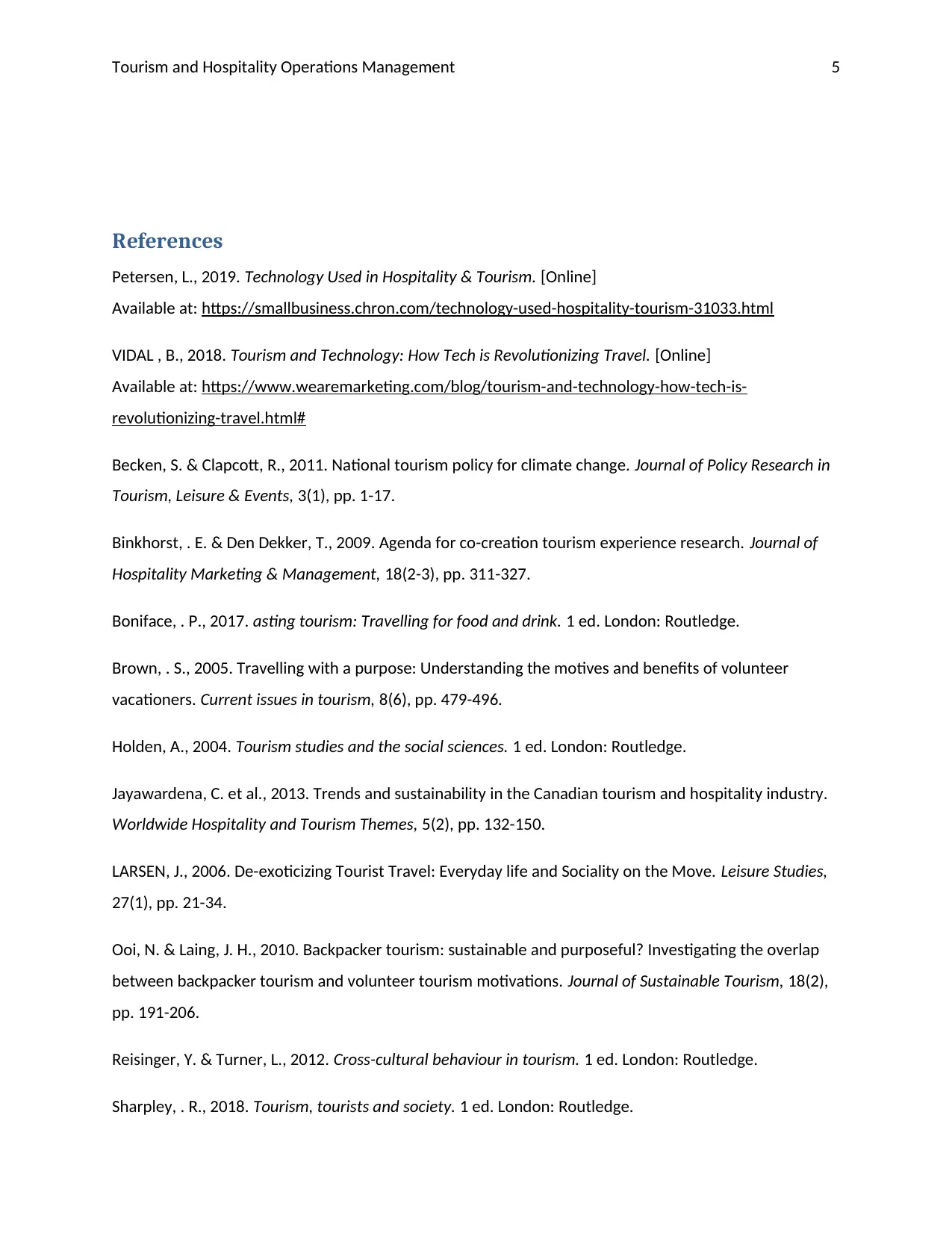
Tourism and Hospitality Operations Management 5
References
Petersen, L., 2019. Technology Used in Hospitality & Tourism. [Online]
Available at: https://smallbusiness.chron.com/technology-used-hospitality-tourism-31033.html
VIDAL , B., 2018. Tourism and Technology: How Tech is Revolutionizing Travel. [Online]
Available at: https://www.wearemarketing.com/blog/tourism-and-technology-how-tech-is-
revolutionizing-travel.html#
Becken, S. & Clapcott, R., 2011. National tourism policy for climate change. Journal of Policy Research in
Tourism, Leisure & Events, 3(1), pp. 1-17.
Binkhorst, . E. & Den Dekker, T., 2009. Agenda for co-creation tourism experience research. Journal of
Hospitality Marketing & Management, 18(2-3), pp. 311-327.
Boniface, . P., 2017. asting tourism: Travelling for food and drink. 1 ed. London: Routledge.
Brown, . S., 2005. Travelling with a purpose: Understanding the motives and benefits of volunteer
vacationers. Current issues in tourism, 8(6), pp. 479-496.
Holden, A., 2004. Tourism studies and the social sciences. 1 ed. London: Routledge.
Jayawardena, C. et al., 2013. Trends and sustainability in the Canadian tourism and hospitality industry.
Worldwide Hospitality and Tourism Themes, 5(2), pp. 132-150.
LARSEN, J., 2006. De-exoticizing Tourist Travel: Everyday life and Sociality on the Move. Leisure Studies,
27(1), pp. 21-34.
Ooi, N. & Laing, J. H., 2010. Backpacker tourism: sustainable and purposeful? Investigating the overlap
between backpacker tourism and volunteer tourism motivations. Journal of Sustainable Tourism, 18(2),
pp. 191-206.
Reisinger, Y. & Turner, L., 2012. Cross-cultural behaviour in tourism. 1 ed. London: Routledge.
Sharpley, . R., 2018. Tourism, tourists and society. 1 ed. London: Routledge.
References
Petersen, L., 2019. Technology Used in Hospitality & Tourism. [Online]
Available at: https://smallbusiness.chron.com/technology-used-hospitality-tourism-31033.html
VIDAL , B., 2018. Tourism and Technology: How Tech is Revolutionizing Travel. [Online]
Available at: https://www.wearemarketing.com/blog/tourism-and-technology-how-tech-is-
revolutionizing-travel.html#
Becken, S. & Clapcott, R., 2011. National tourism policy for climate change. Journal of Policy Research in
Tourism, Leisure & Events, 3(1), pp. 1-17.
Binkhorst, . E. & Den Dekker, T., 2009. Agenda for co-creation tourism experience research. Journal of
Hospitality Marketing & Management, 18(2-3), pp. 311-327.
Boniface, . P., 2017. asting tourism: Travelling for food and drink. 1 ed. London: Routledge.
Brown, . S., 2005. Travelling with a purpose: Understanding the motives and benefits of volunteer
vacationers. Current issues in tourism, 8(6), pp. 479-496.
Holden, A., 2004. Tourism studies and the social sciences. 1 ed. London: Routledge.
Jayawardena, C. et al., 2013. Trends and sustainability in the Canadian tourism and hospitality industry.
Worldwide Hospitality and Tourism Themes, 5(2), pp. 132-150.
LARSEN, J., 2006. De-exoticizing Tourist Travel: Everyday life and Sociality on the Move. Leisure Studies,
27(1), pp. 21-34.
Ooi, N. & Laing, J. H., 2010. Backpacker tourism: sustainable and purposeful? Investigating the overlap
between backpacker tourism and volunteer tourism motivations. Journal of Sustainable Tourism, 18(2),
pp. 191-206.
Reisinger, Y. & Turner, L., 2012. Cross-cultural behaviour in tourism. 1 ed. London: Routledge.
Sharpley, . R., 2018. Tourism, tourists and society. 1 ed. London: Routledge.
⊘ This is a preview!⊘
Do you want full access?
Subscribe today to unlock all pages.

Trusted by 1+ million students worldwide
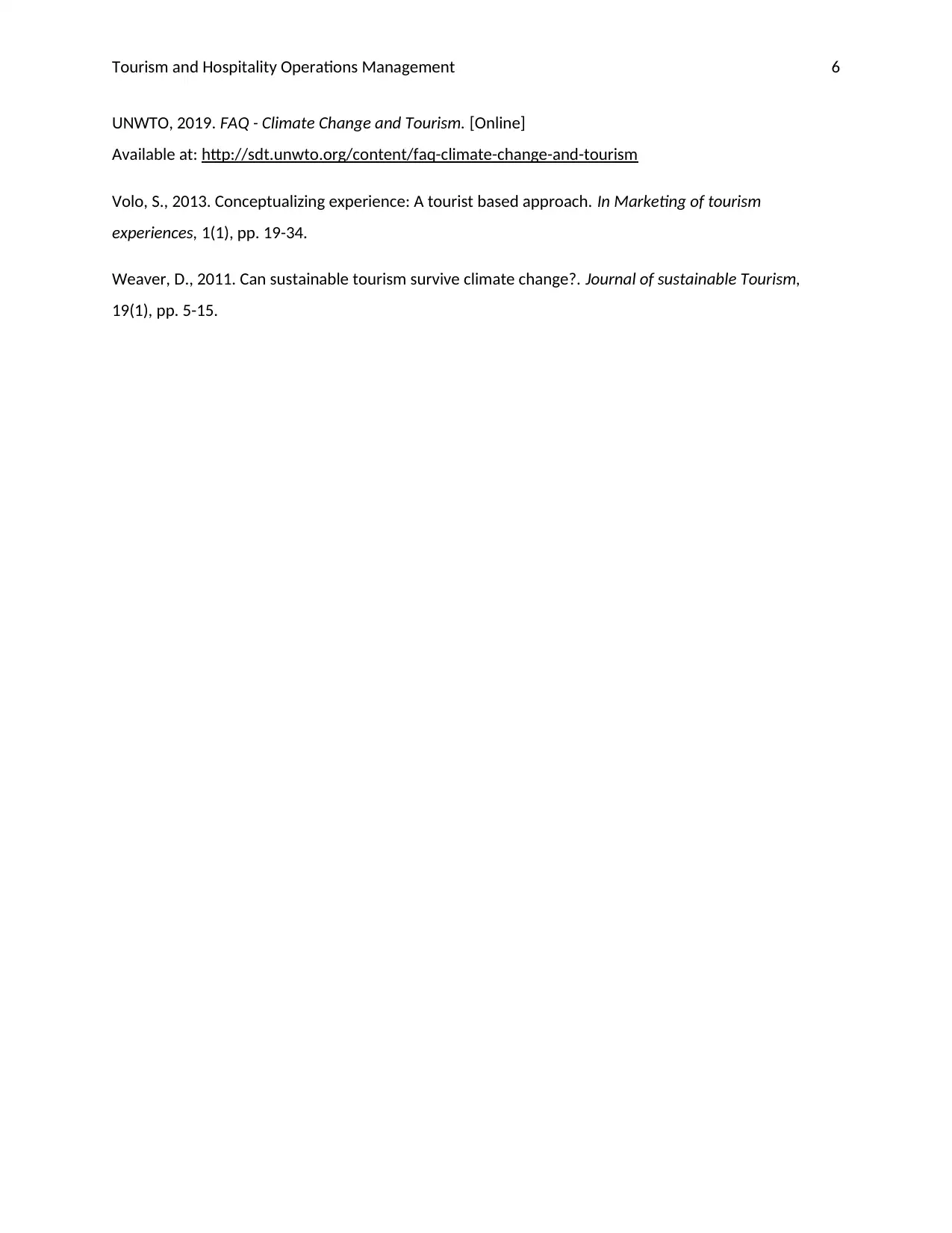
Tourism and Hospitality Operations Management 6
UNWTO, 2019. FAQ - Climate Change and Tourism. [Online]
Available at: http://sdt.unwto.org/content/faq-climate-change-and-tourism
Volo, S., 2013. Conceptualizing experience: A tourist based approach. In Marketing of tourism
experiences, 1(1), pp. 19-34.
Weaver, D., 2011. Can sustainable tourism survive climate change?. Journal of sustainable Tourism,
19(1), pp. 5-15.
UNWTO, 2019. FAQ - Climate Change and Tourism. [Online]
Available at: http://sdt.unwto.org/content/faq-climate-change-and-tourism
Volo, S., 2013. Conceptualizing experience: A tourist based approach. In Marketing of tourism
experiences, 1(1), pp. 19-34.
Weaver, D., 2011. Can sustainable tourism survive climate change?. Journal of sustainable Tourism,
19(1), pp. 5-15.
1 out of 7
Related Documents
Your All-in-One AI-Powered Toolkit for Academic Success.
+13062052269
info@desklib.com
Available 24*7 on WhatsApp / Email
![[object Object]](/_next/static/media/star-bottom.7253800d.svg)
Unlock your academic potential
Copyright © 2020–2025 A2Z Services. All Rights Reserved. Developed and managed by ZUCOL.





